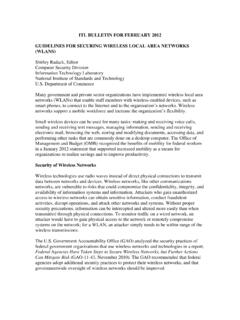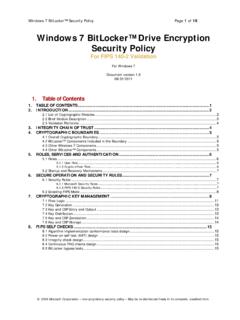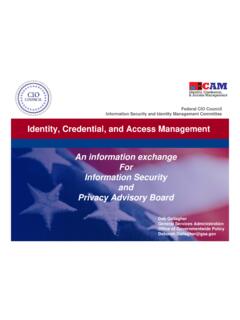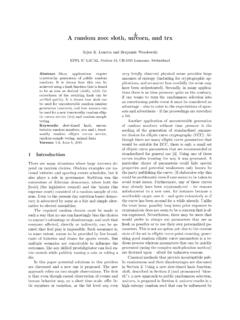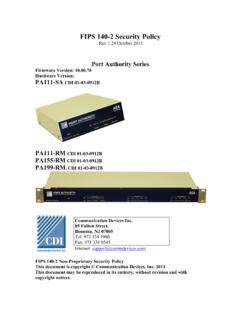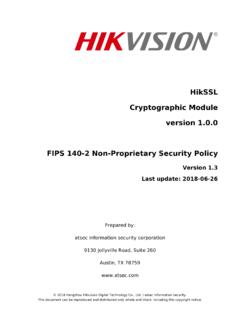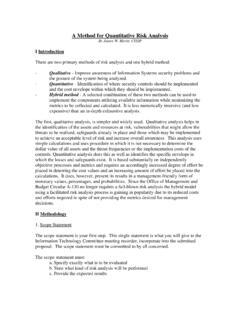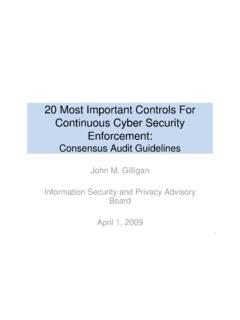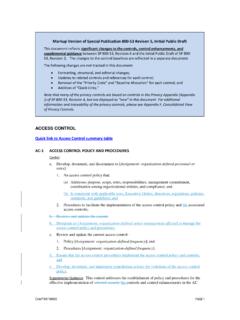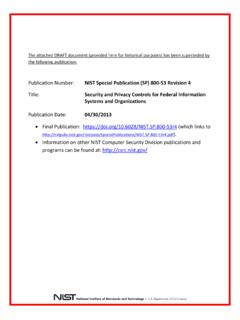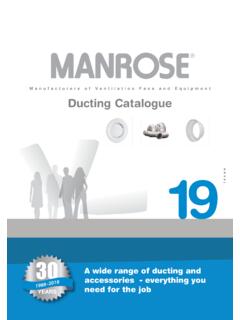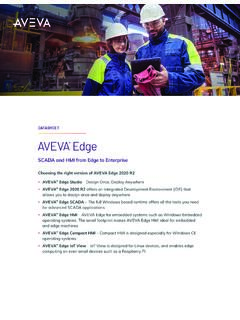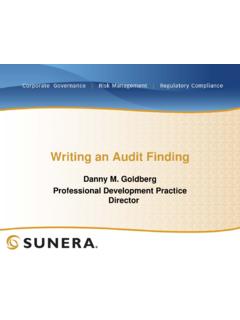Transcription of NIST Cyber Risk Scoring (CRS)
1 NIST Cyber Risk Scoring (CRS)Program OverviewFebruary 2021 Agenda CRS Project Background Risk Profiling and Risk Scoring Information Security Continuous Monitoring (ISCM) & Ongoing Authorization (OA) Privacy Capabilities Management Dashboards Questions?2 Assessing, Understanding, and Managing Security and Privacy Risks3 NIST s Cyber Risk Scoring (CRS) Solution enhances NIST s security & privacy Assessment & Authorization (A&A) processes by presenting real-time, contextualized risk data to improve situational awareness and prioritize required actions. Previous ProcessCRS SolutionBenefits of CRS Integrated view of NIST risk posture across the enterprise with quantitative metrics across systems and components More frequent, meaningful and actionable risk information to System Owners & Authorizing Officials Improved efficiency through automating assessments of certain controls and auto-generation of ATO documentation A data-driven basis for ongoing authorization decisions Present the organization s overall security posture from different perspectives, , the Risk Management Framework (RMF)
2 And Cyber Security Framework (CSF)4 CRS CapabilitiesArcher: Prioritize security & privacy control assessments Manage A&A and significant change schedules Track Accepted Risks and POA&M milestones Generate security and privacy documentation Provide compliance and vulnerabilities scan results in near-real timeTableau: View risk at multiple organizational levels Integrate vulnerability data into risk Scoring Drill-down into specific assets and their current vulnerability exposures Respond to data calls quickly with details ( CVEs and affected assets) Analyze risks against the CSF 5 The CRS toolset provides end users the following capabilities.
3 CRS Inputs6 ArcherSystem & Component Descriptions Common Control DescriptionsData Types /Risk Profile Questionnaire ResponsesAutomated Asset DataAutomated Vulnerability DataISCM A&A ResultsPOA&Ms and Accepted RisksThese data are ingested into Archer and analyzed for presentation in Tableau. CRS Outputs7 After analysis users can generate ATO documentation on-demand & view metric-based risk management dashboards. Archer and TableauCIO and Executive DashboardsCSF DashboardNIST Asset Management DashboardSecurity & Privacy documents (SAP, SAR, PAR, PTA, & PIA)System Security and Privacy DashboardsGo-Live DashboardsRisk Profiling and Scoring8 Risk Profiling Overview Risk Profiling is a process that allows NIST to determine the importance of a system to the organization s mission.
4 By first understanding the business and technical characteristics that impact system risk, an agency can identify and align controls to a component based on the likelihood that a weakness will be exploited and the potential impact to the Develop Business and Technical Characteristics3. Determine Tailoring Logic & Apply Common Controls4. Incorporate Compliance and Vulnerability Data5. deploy Continuous Monitoring1. Define Organization s Risk Factors and Priorities Organization s priorities and risk appetite is determined by receiving input from stakeholdersto customize a security questionnaire that will best fit the organization s security : Risk Profile MultiplierOutput: Applicable Controls and Total Potential RiskOutput: Total View of RiskOutput: Metric ReportsOutput: Risk Profile MethodologyQuestionnaireis created to reflect organization s business processes and technical environment.
5 Likelihood and threat factors tied to these characteristics are quantified. The Risk Profile leverages Common Control Providers and scoping considerations to reduce the number of controls to be assessed, narrowing the scope of work while maintaining security , compliance, and vulnerability data is continuously recorded in the Risk Profile to determine the risk posture of the information Risk Profile makes it possible to perform Continuous Monitoring of all implemented security and privacy controls by using a risk-based approach to prioritize control Scoring VariablesRisk Scoring provides a foundation for quantitative risk-based analysis, assessment, and reporting of organizational IT assets.
6 By applying ratings to controls and generating scores for components, stakeholders have a relative understanding of risk from one system compared to another. The variables that can affect a control s potential risk score is outlined below. VariableDescriptionConsiderationsControl Baseline Risk ScoreEvery control is assigned an initial weighting (1-10) based on an analysis of its importance to the security and privacy posture. What is the potential security impact of this control to NIST?Data Type Questionnaire ResponsesInitial CIA ratings (1-10) are assigned to controls, based on criticality of the information type(s), upon completion of the Data Type Questionnaire.
7 What is the impact of Confidentiality (C), Integrity (I), and Availability (A) to the types of information that are used within this component?Risk Profile Questionnaire ResponsesAdditional adjustments are applied as indicated by responses to the Risk Profile Questionnaire, including business risks. What assets or applications are part of the component? What is potential security impact of this component to the enterprise?10 Risk Calculation Overview11 Complete QuestionnairesGenerate Risk Profile Calculate Risk Score Data Type Questionnaire: Determines an overall system security category for the component, assigns the security control baseline (Low/Moderate/High), and calculates initial risk score modifier.
8 Risk Profile Questionnaire: Performs additional control scoping and calculates final risk score modifiers for the resulting set of applicable controls. The Risk Profile outlines the controls that should be implemented. Security controls are assigned ratingsfor Confidentiality, Integrity, and Availability to quantify risks. Components are assessed based on their implementation of these controls. The sumof all Component potential risk equals the System potential risk Final scores include a multitude of security inputs ( , manual inputs, vulnerabilities, compliance scans).
9 Risk scores create the ability to make apples-to-apples comparisons across the following steps are completed in Archer for each system component to calculate potential risk. Information Security Continuous Monitoring and Ongoing Authorization Approach12 ISCM and OA Overview13 ISCM promotes more frequent and targeted monitoring of system security and privacy posture to enable risk-based Ongoing Authorization (OA) CRS, NIST implements ISCM and OA by: Prioritizing the set of controls to be evaluated for each assessment Providing on-demand reporting of security and privacy metrics (SARs, SAPs, PAPs, and PARs) and management dashboard summariesNIST System ATO ScheduleATOs Expirations ~4/1 ATOs Expirations ~9/30 NIST has 46 operational systems + Common Controls NIST System ATOs are on a semi-annual ATO Cycle ATO status is managed in Cyber Risk Scoring solution (Archer)
10 14 ISCM Schedule for Security Controls15 ControlsYear 1 Year 2 Year 3 Year 4 Year 5 Year 6 DoC Volatile ControlsCommon ControlsHigh Risk Controls*Moderate Risk Controls*Low Risk Controls**Risk score ranges were determined by calculating baseline risk score multipliers Sample Assessment ScheduleAssessment TypeScan FrequencyVulnerabilities WeeklyCompliance Scans MonthlyWeb Applications Annually and as neededAutomated AssessmentsManual Assessments*Full control set assessed annuallyHalf of the control set is assessed each year One third of the control set is assessed each yearOne sixth of the control set is assessed each yearSecurity control assessments are prioritized based on importance to the organization (DoC Volatile Controls and Common Controls) and number of potential risk Process16 System Level DataArcher captures system information that supports ongoing assessment and authorization efforts.
